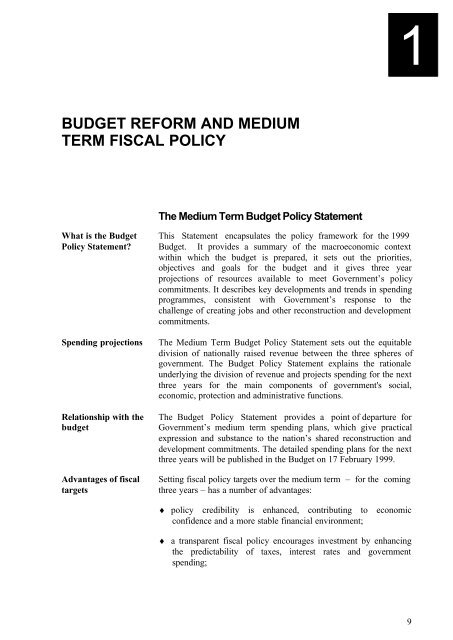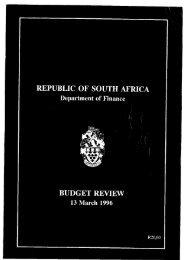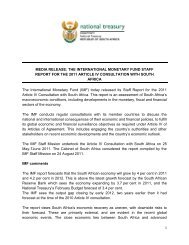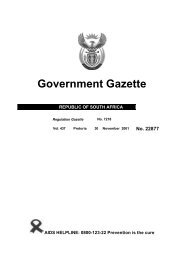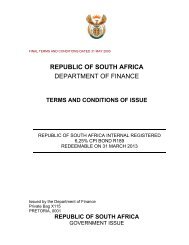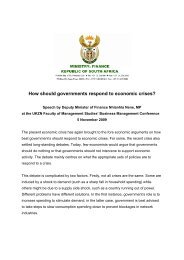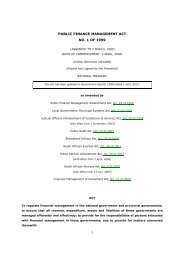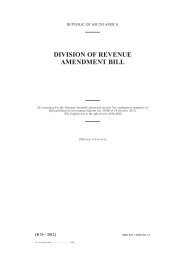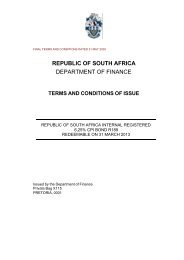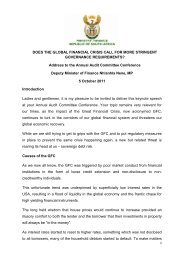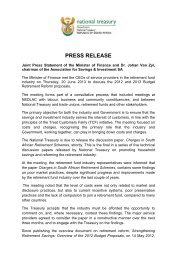Budget Reform and Medium Term Fiscal Policy - National Treasury
Budget Reform and Medium Term Fiscal Policy - National Treasury
Budget Reform and Medium Term Fiscal Policy - National Treasury
You also want an ePaper? Increase the reach of your titles
YUMPU automatically turns print PDFs into web optimized ePapers that Google loves.
1<br />
BUDGET REFORM AND MEDIUM<br />
TERM FISCAL POLICY<br />
The <strong>Medium</strong> <strong>Term</strong> <strong>Budget</strong> <strong>Policy</strong> Statement<br />
What is the <strong>Budget</strong> This Statement encapsulates the policy framework for the 1999<br />
<strong>Policy</strong> Statement? <strong>Budget</strong>. It provides a summary of the macroeconomic context<br />
within which the budget is prepared, it sets out the priorities,<br />
objectives <strong>and</strong> goals for the budget <strong>and</strong> it gives three year<br />
projections of resources available to meet Government’s policy<br />
commitments. It describes key developments <strong>and</strong> trends in spending<br />
programmes, consistent with Government’s response to the<br />
challenge of creating jobs <strong>and</strong> other reconstruction <strong>and</strong> development<br />
commitments.<br />
Spending projections<br />
Relationship with the<br />
budget<br />
Advantages of fiscal<br />
targets<br />
The <strong>Medium</strong> <strong>Term</strong> <strong>Budget</strong> <strong>Policy</strong> Statement sets out the equitable<br />
division of nationally raised revenue between the three spheres of<br />
government. The <strong>Budget</strong> <strong>Policy</strong> Statement explains the rationale<br />
underlying the division of revenue <strong>and</strong> projects spending for the next<br />
three years for the main components of government's social,<br />
economic, protection <strong>and</strong> administrative functions.<br />
The <strong>Budget</strong> <strong>Policy</strong> Statement provides a point of departure for<br />
Government’s medium term spending plans, which give practical<br />
expression <strong>and</strong> substance to the nation’s shared reconstruction <strong>and</strong><br />
development commitments. The detailed spending plans for the next<br />
three years will be published in the <strong>Budget</strong> on 17 February 1999.<br />
Setting fiscal policy targets over the medium term – for the coming<br />
three years – has a number of advantages:<br />
♦ policy credibility is enhanced, contributing to economic<br />
confidence <strong>and</strong> a more stable financial environment;<br />
♦ a transparent fiscal policy encourages investment by enhancing<br />
the predictability of taxes, interest rates <strong>and</strong> government<br />
spending;<br />
9
1998 <strong>Medium</strong> <strong>Term</strong> <strong>Budget</strong> <strong>Policy</strong> Statement<br />
♦ a medium term fiscal framework facilitates transformation by<br />
creating an integrated planning framework, indicating broad<br />
dimensions of budget reprioritisation <strong>and</strong> providing a baseline<br />
against which policy changes can be assessed;<br />
♦ by planning spending over the medium term, government<br />
improves the allocation <strong>and</strong> efficiency of public spending; <strong>and</strong><br />
♦ the medium term framework encourages public discussion <strong>and</strong><br />
debate of policy priorities within the context of consistent<br />
macroeconomic <strong>and</strong> budget projections.<br />
<strong>Budget</strong> reform<br />
The <strong>Medium</strong> <strong>Term</strong><br />
Expenditure<br />
Framework<br />
The <strong>Medium</strong> <strong>Term</strong> Expenditure Framework is one of three broad<br />
reforms to the budget process. The 1999 <strong>Budget</strong> will be the second<br />
to include spending projections for the next three fiscal years. The<br />
key features of the <strong>Medium</strong> <strong>Term</strong> Expenditure Framework are:<br />
♦ publication of three-year forward estimates when the <strong>Budget</strong> is<br />
tabled in Parliament;<br />
♦ a focus on outputs <strong>and</strong> outcomes of government spending<br />
programmes as part of the budget review process;<br />
♦ a cooperative approach to expenditure analysis <strong>and</strong> planning,<br />
involving national <strong>and</strong> provincial treasuries <strong>and</strong> spending<br />
departments;<br />
♦ more detailed budget information to promote underst<strong>and</strong>ing <strong>and</strong><br />
debate in Parliament <strong>and</strong> civil society; <strong>and</strong><br />
♦ a budget process aimed at informed political responsibility for<br />
budget priorities <strong>and</strong> spending plans.<br />
Adjustments to The three-year projections of expenditure introduced in the<br />
forward estimates 1998 <strong>Budget</strong> provide the baseline estimates for planning the 1999<br />
<strong>Budget</strong>, <strong>and</strong> allow spending implications to be properly assessed<br />
when policy options come under consideration. Reviews of<br />
expenditure during the course of the budget process or shifts in<br />
priorities may lead political office-bearers to consider changes in the<br />
forward estimates. <strong>Policy</strong> changes will thus typically lead to specific<br />
adjustments to the baseline spending plan.<br />
This three-year rolling budget framework means that departments<br />
can plan <strong>and</strong> reprioritise with greater certainty about future resource<br />
allocations than in the past. It also provides Parliament <strong>and</strong> civil<br />
society with clear signals of Government’s spending intentions.<br />
10
Chapter 1: <strong>Budget</strong> <strong>Reform</strong> <strong>and</strong> <strong>Medium</strong> <strong>Term</strong> <strong>Fiscal</strong> <strong>Policy</strong><br />
Evaluation of<br />
spending plans<br />
The <strong>Treasury</strong><br />
Control Bill<br />
On <strong>Budget</strong> Day, Parliament is presented with a set of three-year<br />
spending plans, but is only asked to vote on the budget for the<br />
coming year. The three-year spending projections allow Parliament,<br />
institutions of civil society <strong>and</strong> particular interest groups to evaluate<br />
Government’s reconstruction <strong>and</strong> development goals <strong>and</strong> objectives<br />
in relation to envisaged spending plans. While the vigour of public<br />
debate will no doubt remain undiminished, its substance <strong>and</strong> quality<br />
are enhanced by the transparency <strong>and</strong> extent of information<br />
Government provides in the new approach to expenditure planning.<br />
The second key component of the budget reform process is the<br />
<strong>Treasury</strong> Control Bill. This gives effect to the Constitutional<br />
requirement for national legislation to:<br />
♦ establish a <strong>National</strong> <strong>Treasury</strong>;<br />
♦ introduce generally recognised accounting practices;<br />
♦ introduce uniform norms <strong>and</strong> st<strong>and</strong>ards;<br />
♦ prescribe expenditure control in all spheres of government; <strong>and</strong><br />
♦ set the operational procedures for borrowing, procurement <strong>and</strong><br />
oversight over the various <strong>National</strong> <strong>and</strong> Provincial Revenue<br />
Funds.<br />
The <strong>Treasury</strong> Control Bill sets the stage for the introduction of<br />
further budget reforms by introducing an approach to the<br />
management of public finances that focuses on outputs <strong>and</strong><br />
responsibilities. The shift in emphasis toward outputs rather than<br />
expenditure regulations will be taken further in the <strong>Budget</strong> <strong>Reform</strong><br />
White Paper to be published early next year.<br />
Responsibilities of<br />
office-bearers<br />
The <strong>Treasury</strong> Control Bill clarifies the respective responsibilities of<br />
the political head <strong>and</strong> the official head of a department or agency.<br />
In broad terms, the political head is responsible for policy matters,<br />
including the preparation of the <strong>Budget</strong> <strong>and</strong> ensuring that the<br />
administrative head is implementing the budget in line with policy<br />
objectives.<br />
The administrative head is accountable to the political head for the<br />
implementation of the budget, <strong>and</strong> accountable to Parliament for<br />
financial management. The Bill includes provision for penalties or<br />
sanctions in the event of failure of accounting officers to discharge<br />
their responsibilities.<br />
11
1998 <strong>Medium</strong> <strong>Term</strong> <strong>Budget</strong> <strong>Policy</strong> Statement<br />
Accounting officers<br />
Four specific areas of responsibility of accounting officers are set<br />
out:<br />
♦ operation of basic financial systems;<br />
♦ ensuring that departments do not overspend their budgets;<br />
♦ regular financial reporting; <strong>and</strong><br />
♦ publication of reports covering outputs <strong>and</strong> performance, in a<br />
prescribed format.<br />
Overhaul of financial<br />
management<br />
The <strong>Budget</strong> <strong>Reform</strong><br />
White Paper<br />
<strong>Budget</strong> reform<br />
challenges<br />
The <strong>Treasury</strong> Control Bill lays the basis for phasing in a major<br />
overhaul of financial management. This will include, amongst other<br />
things, the introduction of appropriation control <strong>and</strong> accountability<br />
arrangements for the management of budgets. As these principles<br />
take root, the emphasis will increasingly turn to oversight of the<br />
efficiency <strong>and</strong> effectiveness of programmes <strong>and</strong> qualitative<br />
improvements in financial management practice.<br />
As noted in last year’s <strong>Medium</strong> <strong>Term</strong> <strong>Budget</strong> <strong>Policy</strong> Statement, a<br />
longer term budget reform strategy is to be published in the form of<br />
a White Paper. This sets out proposals for more effective budgeting<br />
<strong>and</strong> financial management, aimed at strengthening the links between<br />
resource allocation <strong>and</strong> the delivery of services consistent with social<br />
<strong>and</strong> development priorities.<br />
The budget reform process must deal in practical ways with the<br />
challenges of South Africa’s fiscal environment:<br />
♦ a cooperative governance framework, in which key policies <strong>and</strong><br />
their implementation are managed jointly by national <strong>and</strong><br />
provincial governments;<br />
♦ the translation of agreed policy goals into delivery of public<br />
services;<br />
♦ the need to make choices so that resources are used to maximise<br />
Government’s reconstruction <strong>and</strong> development aims, meet basic<br />
needs <strong>and</strong> ensure redistribution;<br />
♦ the promotion of democratic accountability <strong>and</strong> greater<br />
transparency <strong>and</strong> underst<strong>and</strong>ing of the nation’s budget; <strong>and</strong><br />
♦ greater effectiveness in the management of public resources to<br />
deliver services more efficiently <strong>and</strong> fairly.<br />
Devolution of<br />
decision-making<br />
These challenges underscore the need for a coherent vision of the<br />
budgeting system. The White Paper will set out proposals for greater<br />
devolution of powers of decision-making, empowering departments<br />
12
Chapter 1: <strong>Budget</strong> <strong>Reform</strong> <strong>and</strong> <strong>Medium</strong> <strong>Term</strong> <strong>Fiscal</strong> <strong>Policy</strong><br />
to allocate resources <strong>and</strong> manage their personnel <strong>and</strong> other inputs to<br />
improve service delivery. It will provide a clearer role for accounting<br />
officers in linking responsibility for resources to identified services,<br />
outputs <strong>and</strong> outcomes. It will outline tougher enforcement of<br />
controls, including improved financial accounting systems, more<br />
rapid audit <strong>and</strong> tougher penalties for over-spending or inappropriate<br />
use of funds.<br />
These are inter-dependent reforms. If decision-makers are to be<br />
accountable for their actions, management responsibilities must be<br />
devolved to them. By the same token, devolution of decision-making<br />
requires a framework of accountability, <strong>and</strong> information systems to<br />
support decision-makers.<br />
<strong>Medium</strong> term fiscal policy<br />
The budget reform initiatives discussed above are aimed at fostering<br />
a sound allocation of resources through the budget process. At the<br />
same time, Government remains committed to a sustainable overall<br />
fiscal stance, consistent with a stable macroeconomic environment<br />
that promotes investment, supports job creation <strong>and</strong> improves the<br />
st<strong>and</strong>ard of living for all.<br />
What is fiscal policy?<br />
<strong>Fiscal</strong> policy deals with the levels <strong>and</strong> composition of taxation,<br />
spending <strong>and</strong> borrowing by government. <strong>Fiscal</strong> policy encompasses<br />
several fundamental policy issues, including the proper role <strong>and</strong> size<br />
of the state, the role of government in promoting growth, job<br />
creation, social development <strong>and</strong> redistribution, the nature <strong>and</strong> extent<br />
of public services <strong>and</strong> fairness between the present <strong>and</strong> future<br />
generations of South Africans. Government’s fiscal policy has both<br />
microeconomic <strong>and</strong> macroeconomic objectives.<br />
Improved distribution Microeconomic objectives include an improved distribution of<br />
<strong>and</strong> economic efficiency income <strong>and</strong> wealth, equitable access to social services, meeting the<br />
basic needs of the poor, promoting investment in public goods, <strong>and</strong><br />
enhancing the efficiency with which the public <strong>and</strong> private sectors<br />
produce goods <strong>and</strong> services <strong>and</strong> their responsiveness to the needs of<br />
consumers.<br />
Promoting growth <strong>and</strong><br />
development<br />
Microeconomic<br />
objectives of fiscal<br />
policy<br />
Macroeconomic objectives relate to evolution of the economy as a<br />
whole – national income <strong>and</strong> output, jobs, inflation <strong>and</strong> the balance<br />
of payments.<br />
Government's fiscal policy seeks to invest in public services that<br />
contribute to future productivity, employment creation <strong>and</strong> improved<br />
living st<strong>and</strong>ards. The reprioritisation of government spending aims to<br />
redirect public resources to spending areas that promote sustainable<br />
13
1998 <strong>Medium</strong> <strong>Term</strong> <strong>Budget</strong> <strong>Policy</strong> Statement<br />
growth, while also providing safety <strong>and</strong> security <strong>and</strong> promoting the<br />
efficient administration of justice.<br />
Investing in people<br />
Tax fairness<br />
Encouraging<br />
investment<br />
The budget includes provision for social grants targeted to protect<br />
the incomes of the poor, equitable access to schooling, support for<br />
training <strong>and</strong> higher education <strong>and</strong> an extensive public health system.<br />
By investing in people, Government seeks to extend opportunities to<br />
all <strong>and</strong> promote productivity <strong>and</strong> social well-being.<br />
<strong>Fiscal</strong> policy must also ensure that the level <strong>and</strong> structure of taxes<br />
promote equity <strong>and</strong> redistribution, <strong>and</strong> do not interfere unduly in<br />
people’s investment <strong>and</strong> consumption decisions.<br />
Government promotes a financial environment in which the nation’s<br />
savings are directed towards productive investments, both in<br />
business enterprises <strong>and</strong> public infrastructure. By moderating the<br />
claims of the public sector on available savings, fiscal policy<br />
contributes to lower real interest rates, which in turn encourages<br />
investment, productivity <strong>and</strong> growth.<br />
Macroeconomic Government’s fiscal policy is aimed at promoting stability, jobs <strong>and</strong><br />
objectives of fiscal growth. A sound macroeconomic environment encourages<br />
policy<br />
investment in the economy, both domestically <strong>and</strong> from abroad, to<br />
create more jobs <strong>and</strong> a higher st<strong>and</strong>ard of living. <strong>Fiscal</strong> policy also<br />
seeks to create a climate conducive to increased domestic saving, to<br />
limit the extent to which South Africa is dependent on foreign<br />
savings <strong>and</strong> investment.<br />
Affordable spending<br />
targets<br />
Debt <strong>and</strong> interest<br />
In addition, Government recognises that public expenditure must be<br />
kept at an affordable level, <strong>and</strong> that spending must be matched by<br />
revenue – either currently or when debt obligations fall due. By<br />
keeping spending commitments in line with current <strong>and</strong> future<br />
revenue trends, fiscal policy contributes to low inflation <strong>and</strong> a<br />
sustainable balance of payments.<br />
Against the background of relatively high public sector borrowing<br />
requirements in the past, a rising ratio of debt to national income <strong>and</strong><br />
an excessive interest burden on the budget, Government aims to<br />
lower the annual budget deficit to 3 per cent of GDP within the next<br />
two years. This will ensure that government debt does not grow<br />
faster than government’s ability to meet debt service payments.<br />
Government also aims to strengthen public sector investment<br />
spending as part of a broader commitment to building the productive<br />
capacity of the economy.<br />
These fiscal objectives are part of an integrated macroeconomic<br />
strategy, aimed at more growth <strong>and</strong> jobs, <strong>and</strong> sustainable<br />
improvements in the st<strong>and</strong>ard of living of all South Africans.<br />
14
Chapter 1: <strong>Budget</strong> <strong>Reform</strong> <strong>and</strong> <strong>Medium</strong> <strong>Term</strong> <strong>Fiscal</strong> <strong>Policy</strong><br />
A revised budget framework<br />
Adaptation to This Statement explains several significant shifts in the<br />
changed economic macroeconomic <strong>and</strong> fiscal environment since the publication of the<br />
environment<br />
1998 <strong>Budget</strong>. The revised budget framework set out in chapter 3 is<br />
part of Government’s response to the dramatic changes of the last<br />
six months in the international financial context. A slowdown in<br />
economic growth has led to adjustments in spending <strong>and</strong> tax plans.<br />
Higher interest rates have impacted sharply on resources available<br />
for service delivery.<br />
<strong>Budget</strong> priorities<br />
Revised division<br />
of revenue<br />
At the same time, chapter 4 of this Statement indicates several shifts<br />
in spending priorities in support of employment creation <strong>and</strong><br />
stronger public investment. Government’s commitment to effective<br />
policing <strong>and</strong> a revitalised justice system is outlined. <strong>Reform</strong>s aimed<br />
at better management of education, health <strong>and</strong> welfare services<br />
provided by provinces are noted.<br />
Shifts in priorities are also reflected in the allocation of resources<br />
between the spheres of government. Chapter 5 details a revised<br />
division of revenue between national, provincial <strong>and</strong> local<br />
government. Chapter 6 outlines likely spending trends over the next<br />
three years.<br />
In setting out these policy considerations, Government invites<br />
Parliament, citizens <strong>and</strong> the institutions of civil society to contribute<br />
to the making of sound budgets, honest evaluation of policies <strong>and</strong><br />
programmes <strong>and</strong> steady progress in implementing improved public<br />
services.<br />
15
1998 <strong>Medium</strong> <strong>Term</strong> <strong>Budget</strong> <strong>Policy</strong> Statement<br />
16


